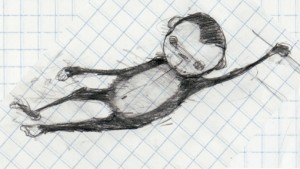don’t forget the monkey.
Posted on October 9, 2011 | posted by:Out one night with friends I was explaining the Transdisiplinary Design program. I stumbled on this a bit because of the mercurial nature of the program and it’s reluctance to be solidly defined. One friend wondered: “So if a question is asked, you’re looking not for the possible answers to be A, B or C, but that the possible answers could be A, 2 or Monkey?” I laughed, we all laughed but then I realized that he was on to something. A, 2 or Monkey as possible solutions implies that we are thinking not in terms of a single method or from a narrow platform but that the answers we may devise come in many divergent forms and from very different processes.
I thought immediately of one of the first of many reading requirements designed to give us, the new students to Transdisciplinary Design, a common language in which to have critical dialog and to establish a foundation in which to develop new processes, Rittle and Webber’s “Dilemmas In A General Theory Of Planning”. Rittle and Webber define societal problems as “wicked problem”. They preface the “wicked problem” on page 159 with:
…that one of the most intractable problems is that of defining problems (of knowing what distinguishes an observed condition from a desired condition) and of locating problems (finding where in the complex casual networks the trouble really lies). In turn, and equally intractable, is the problem of identifying the actions that might effectively narrow the gap between what-is and what-ought-to-be.
The stickiest problem with solving problems is defining the problem! Wow! But it doesn’t stop there the logic seemingly doubles back on us as we read further into the text. From page 161:
The formulation of a wicked problem is the problem! The process of formulating the problem and of conceiving a solution (or re- solution) are identical, since every specification of the problem is a specification of the direction in which a treatment is considered.
This sounds similar to the earlier quote but the devil is really in the detail here. I read this to mean that not only is the “wicked problem” found in defining the problem but when you finally come to a conclusion and have said: “ Yes! THIS is the problem!” that’s when the “wicked problem” really rears its ugly head.
A good explanation of this, from the text:
Consider, for example, what would be necessary in identifying the nature of the poverty problem. Does poverty mean low income? Yes, in part. But what are the determinants of low income? Is it deficiency of the national and regional economies, or is it deficiencies of cognitive and occupational skills within the labor force? If the latter, the problem statement and the problem “solution” must encompass the educational processes. But, then, where within the educational system does the real problem lie? What then might it mean to “improve the educational system”? Or does the poverty problem reside in deficient physical and mental health? If so, we must add those etiologies to our information package, and search inside the health services for a plausible cause. Does it include cultural deprivation? spatial dislocation? problems of ego identity? deficient political and social skills?- and so on. …To find the problem is thus the same thing as finding solution; the problem can’t be defined until the solution has been found.
The problem can’t be defined until the solution has been found! Once again, Wow!
The process at first seems counter-intuitive. We usually think in terms of the various answers we may posit for a problem, but then we have come to terms with the complexity in even identifying the problem, and then we realize we must first “solve” the problem to answer the question of what the problem really is. Through solution comes identification.
Going back to my friends query, I realize that more accurately what we are learning in Transdisciplinary Design is not only that the possible solutions can be A, 2 and/or monkey but that we must recognize the problem itself may be A, 2 and/or Monkey. The route we take to formulate “solutions” is not a linear one. Being able to think through solutions to find the problem relies on developing an ability to question our solutions at every turn and to give ourselves a wide enough vantage point to be able to discern the “what-is and what-ought-to-be”.
